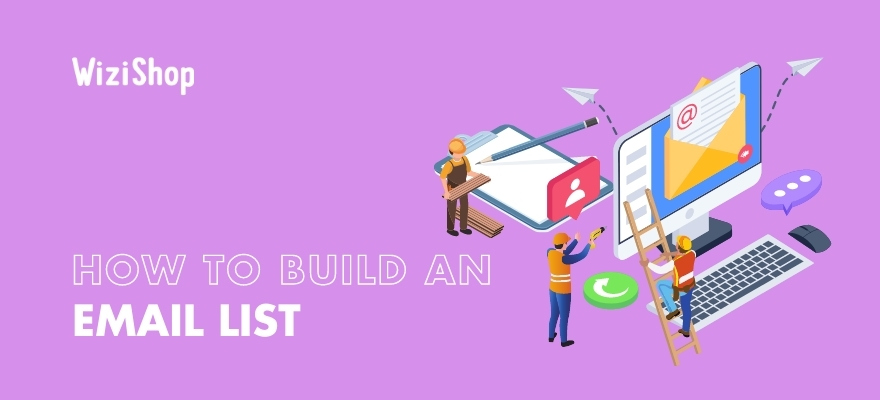Whether you’re just about to launch your first ecommerce business or you’re a seasoned vet when it comes to online sales, it’s essential to work on creating a high-quality email marketing list.
In addition to email addresses, this list will include helpful data related to current and potential customers for your store, like name, gender, location, etc. You’ll then be able to use this list as you develop your email marketing campaigns to promote your business, share your knowledge, and better connect with shoppers.
However, knowing how to take the first step with building an email list can sometimes leave ecommerce entrepreneurs scratching their heads. To be successful with this process and encourage people to subscribe to your emails, you’ll need to be patient and have a well-planned strategy in place to optimize your efforts.
Why is it important to build your email list?
No matter what product you sell, email marketing is beneficial for ecommerce. It allows you to build long-term relationships with your subscribers and grow brand awareness and trust. After a while, ecommerce email marketing can aid you in turning site visitors or potential leads into loyal customers.
What’s more, this marketing strategy generally offers a great average return on investment (ROI) when compared to other channels. In fact, a 2020 study by Statista surveying marketers around the world found that ecommerce businesses earned USD 45 for every dollar spent on email marketing!
As you prepare to work on your email list, keep in mind that obtaining high-quality, relevant data is absolutely crucial.
If you have thousands of email addresses on file but they don’t belong to real people or belong to consumers who aren’t likely to be interested in purchasing your products, that long list isn’t going to do you much good!
How to build your email list
Although you most likely won’t be able to create a single lead form and obtain thousands of leads overnight, combining multiple list-building strategies can help you create a list that’s chock-full of engaged subscribers over time.
To assist you with getting started, here are 15 reliable methods for building your email list!
1. Homepage pop-ups
As your ecommerce website’s homepage may be where many of your potential customers first encounter your business, this can be the perfect place to start with building your email list with the help of pop-ups. Homepage pop-ups generally fall into one of two categories: welcome or exit.
Welcome pop-ups usually appear to visitors a few seconds after their arrival on the page. In contrast, an exit pop-up serves as a kind of last-ditch effort to entice a visitor to stay on the site when they attempt to leave the page.
For both, it’s important to include a clear call to action (CTA) to decrease the chances of the user quickly dismissing the pop-up. While it’s true that pop-ups can be seen as annoying by some consumers, when employed strategically, they can be an excellent tool for not only adding to your email list but also increasing sales for your online store!
To boost the effectiveness of your homepage pop-up, consider mentioning a special promotion, highlighting a specific facet of your business that helps you stand out, or offering a discount.
For instance, when you first visit the Pela website, within just a few seconds, you’re greeted by a pop-up asking if you’d like 10% off your first order. After providing your email address, you’ll be provided with a discount code to use for a future purchase.
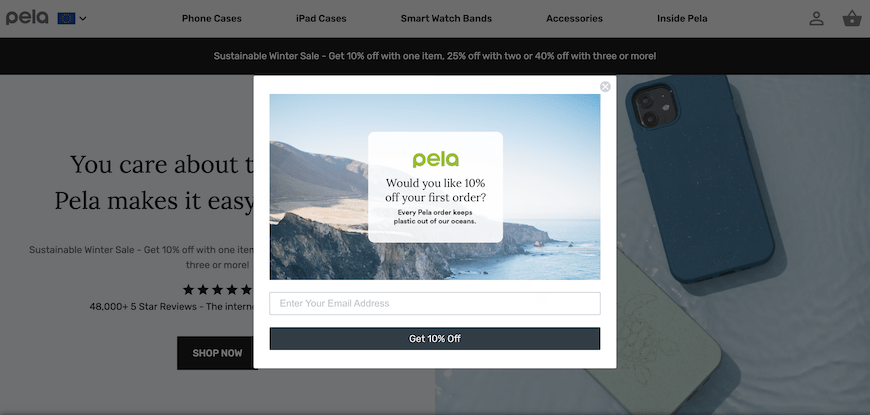
2. Email sign-up forms throughout your website
When shoppers first visit your online store, they may be looking for a specific product, or they may be wanting to discover more about your brand. Consider adding email sign-up forms in areas such as the navigation bar, sidebar, or footer, as these are sections that internet users are likely to check out as they explore your website.
Keep in mind that there’s no need to limit your email list building efforts to your homepage!
Other parts of your ecommerce site that may benefit from the addition of email sign-forms are any place that curious shoppers may frequent, including your “About us” page, your “FAQs” page, etc.
You can also strategically place email sign-up forms in your blog articles or company updates, but avoid going overboard with this, as it could be annoying for readers.
3. Notification sign-ups
Build anticipation for upcoming sales or a product launch and simultaneously grow your email marketing list by employing notification sign-ups on your website. This strategy allows for plenty of flexibility, as you can include them on landing pages, specific product pages—whatever makes the most sense for the type of notification.
Many shoppers will be happy to provide their email address in order to receive exclusive access to news about future promotions or new products or collections that your online store is set to release. Exclusivity combined with the fear of missing out (FOMO) can strongly encourage current and potential customers alike to sign up for notifications so that they don’t miss the chance to enjoy an amazing sale or get first dibs on an exciting new product!
4. Content upgrades
As you’ve probably come to discover, investing your time in high-quality content marketing is well worth the effort in the many benefits that it can bring to your ecommerce business. For starters, it can increase brand awareness and authority, improve engagement, and boost SEO.
However, did you know that you can also use content marketing to obtain email addresses and build your email list? Yep, it’s true!
Types of content such as eBooks, guides, case studies, members-only sales, etc. can all serve as content upgrades or lead magnets. These items tend to offer consumers even more value than the standard blog post. Businesses will generally grant visitors access to this content after they provide their email address via a special form dedicated to the lead magnet.
This strategy tends to work quite well, as users only need to supply their email address to immediately enjoy a free reward.
Note that you can further put your content upgrade in the spotlight by creating a specific landing page for it, as we’ve done for WiziShop’s SEO eBook! If you go this route, just be sure to add an easy-to-understand CTA and form for each visitor to add their email address on the landing page.
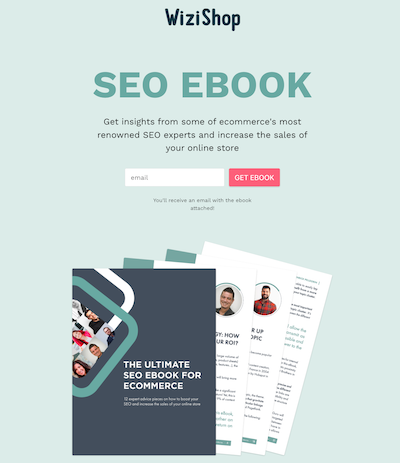
5. Social media
When it comes to ecommerce tips to help make your business more successful, your best plan of action will be to use multiple strategies to achieve your goals rather than sticking to a single strategy.
Your brand is probably already on several social networks, so it makes sense to use your presence on these platforms to also get more newsletter subscribers. Of course, with this plan of action, how you opt to approach building your email list will depend on the specific channel you’re on.
The simplest option is to embed sign-up buttons on your various accounts when possible. For example, on Facebook and Instagram, you can easily create CTA buttons on which your followers can click and become subscribers in an instant.
You can alternatively add links to your bio, for instance on TikTok or Instagram, to send your followers directly to a lead page featuring a sign-up form for your email list. Instagram even offers the option to use Linktree, which permits you to have several links in your bio.
Of course, you can also create posts with a CTA, and depending on the social network, on Facebook and LinkedIn for example, you may be able to insert the link in the post itself.
Another method for building your email list with social media is by launching contests or giveaways. The ability to feature quizzes, polls, Q&As, etc. in Stories can help you to boost your user engagement.
Announcing special events or promotions in this format is an excellent way to increase awareness and drive traffic to landing pages where people are able to sign up to participate. Think about even partnering with influencers to take this strategy to the next level and reach an even larger audience!
6. Surveys
Creating surveys for people to complete is a great method for building your email list, as it also allows you to obtain valuable insight regarding your target market.
The first step involves deciding what subject you’d like to base your survey on. This might be the effectiveness of your customer service, what new products your audience would like you to sell, the kinds of content your followers want to see on social media, etc.
It’ll then be important for you to find a way to entice people to take your survey. While some consumers may be happy to give their opinions for the sake of helping you, especially if they have particularly strong feelings about a certain facet of your business, the majority will probably require an extra incentive. Consider, for instance, offering the first 100 participants a discount on their next purchase.
Don’t forget to include a box or a section for people to include their email addresses in the survey to be able to join your mailing list. As far as creating your survey goes, Google Forms and Typeform are good places to start!
7. Waitlists
Does your online store have a product that’s recently skyrocketed in popularity, causing the item to be sold out? First of all, congrats!
Next, while you’re probably working on getting the product back in stock as soon as possible to keep your customers happy and continue boosting your sales, note that it’s advantageous to create a waitlist in the meantime.
By allowing shoppers to add their email addresses to be alerted when the product is back in stock, you can better keep them informed and increase the chances that they’ll return to your site to make a purchase later. This also allows you to perhaps collect new email addresses for first-time visitors and continue building your email list!
Cult Beauty demonstrates how to effectively employ this strategy in this example with an in-demand Drunk Elephant product.
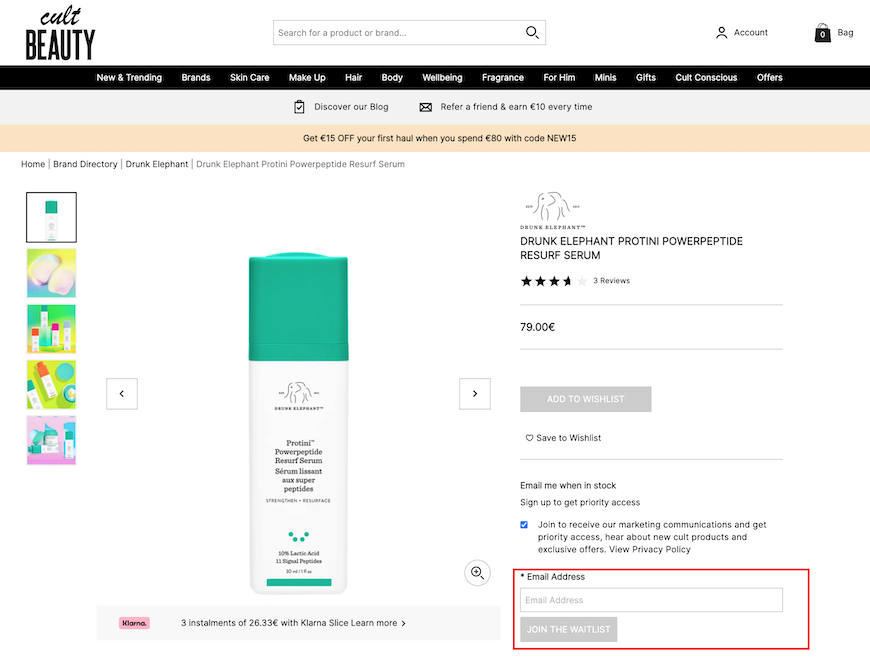
8. Opt-in boxes at checkout
Through your own online shopping experiences, you’ve probably become quite familiar with receiving order confirmations via email. In fact, it’s likely something that you even expect these days.
When online shoppers place an order, it’s not surprising that emails concerning order confirmations as well as those involving shipping updates confirming their order are reassuring. After all, without these emails, they may fear that their orders may have gotten lost in cyberspace!
Because consumers are so used to providing their contact details at checkout, this is a great place to put an opt-in box, which shoppers can check if they’d like to be on your mailing list. As a best practice, make sure that this box is not pre-checked, as this may be seen as invasive or annoying by shoppers, and it may also be illegal, depending on where your business is based.
9. Email signatures
Depending on the size of your ecommerce business, the number of emails that you send on a daily basis may vary. Nevertheless, you’re likely to receive at least the occasional inquiry from potential customers who may want more information regarding, for instance, a certain product or your shipping policies.
As you respond to their questions via email, consider adding a newsletter subscriber link to your email signature. Although you probably won’t get a ton of new subscribers this way, this method makes it easy for curious consumers to sign up and see what your business has to offer!
10. Gamification
As you continue your ecommerce journey, you may find that you’ll need to get creative and go the extra mile to make your brand stand out from the crowd, including when it comes to building your email list!
If your aim is to offer your site visitors a little something different, why not give gamification a go? This entails incorporating interactive items into your strategy to boost engagement and further entice shoppers to provide you with their contact information.
A common form of gamification is a wheel-of-fortune style game where users spin to win a prize such as various discounts or free goodies. Another option is to offer a quiz or test, as demonstrated by Olaplex with their hair diagnostic quiz below.
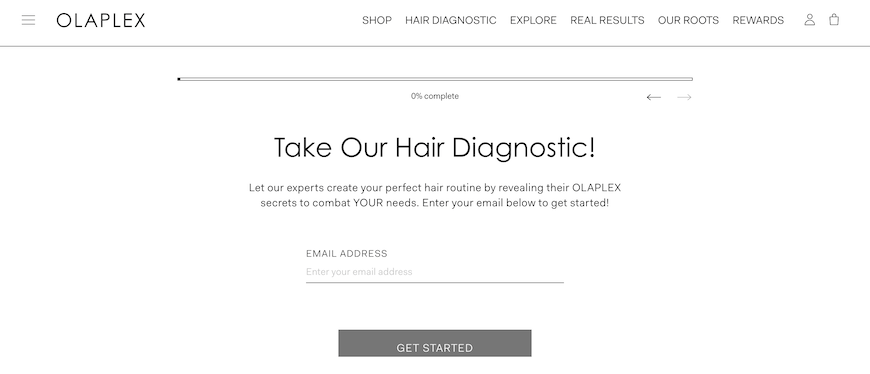
You can opt to make the quiz serious or more light hearted (e.g., helping the user determine the best products to buy from your store based on their astrological sign) and send the results only after the user gives their email address.
People generally love the idea of getting something for free, and many consumers won’t mind giving you their email address if they get to participate in a fun game or quiz that results in some sort of benefit for them.
11. Guest posts
One of the best ways to get more people to subscribe to your emails is simply by guest posting on other websites. By contributing well-written, helpful articles that benefit readers to well-respected blogs relevant to your ideal customer, you’ll be able to share knowledge, expand your reach, and grow your audience.
Furthermore, you’ll likely be able to insert a link in your author bio on the guest post. Although you could of course simply use your online store’s homepage, you can also take advantage of this opportunity and link to a landing page dedicated to a content upgrade, which users can access for free after providing their email.
12. Webinars
Hosting a webinar or an online conference can be a very effective marketing tool, as it gives your audience the opportunity to put a face to the brand. High-quality, informative online events such as these can also help to boost brand authority, increase customer loyalty, and get more people to subscribe to your emails.
To maximize interest in your webinar, opt to focus on a topic that will be of interest to your target market. As you brainstorm subject possibilities for your event, think about what difficulties your audience may be facing, look to see what’s trending on social media, and determine what your most popular blog posts are.
Don’t forget to promote your event on social media platforms like Facebook, LinkedIn, Instagram, etc., write a blog post on the webinar, and create a dedicated landing page on your website. Here, you’ll also want to include a lead form for people to sign up for the event via email.
13. Loyalty programs
Creating a free program that rewards customers for their loyalty to your business is an excellent way to keep them returning to your online store. Another benefit is that it’s perfect for collecting contact details for your email list.
The implementation of loyalty programs is an effective strategy for companies all across the world, regardless of products being sold. In fact, a study published by Statista in 2021 found that businesses worldwide spend around USD 75 billion on managing customer loyalty programs.
However, you’ll just want to ensure that any kind of loyalty program that you opt to set up offers users real value. In addition, ensure that it’s easy for people to find your program, and make it clear as to what the benefits are of joining the loyalty program, as demonstrated in the example below by The Body Shop.
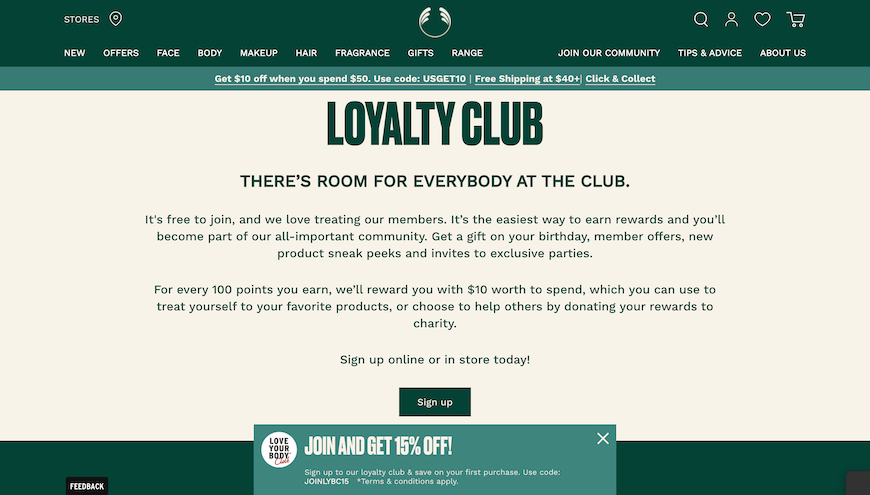
14. Referral programs
Once your online store has started achieving a decent number of sales and you begin to build a network of loyal shoppers, harness the power of word-of-mouth marketing by launching a referral program to get even more customers for your ecommerce business!
A referral program works by providing users with rewards, like discounts for future purchases or freebies from your store, when they refer other people to your website. These current customers receive their reward when, for example, their referrals make a purchase from your business or sign up to receive your newsletter.
This strategy can be pretty helpful for boosting traffic as well as getting subscribers to join your email list, as people tend to have more confidence in the recommendations of their family and friends than those of companies themselves.
An alternative approach is to insert a link to unique content or to an exclusive event in your newsletter. Then, allow your current subscribers access to this information only if they send another person to your newsletter via a special referral link.
15. Pop-up events
The benefits of setting up a pop-up shop or temporary retail space for your ecommerce business are numerous. With this strategy, you can increase brand awareness, meet customers in person, test new markets that you may be considering, boost sales, and more!
What’s more, a pop-up shop offers a great opportunity to grow your email list. For instance, at your pop-up event, you might bring a notebook, clipboard, or iPad and request that people provide their names and email addresses to receive updates from your brand when they stop by.
Although some visitors might be perfectly happy to offer their contact information right away, others might need a bit more convincing. An easy way to do this is to offer an incentive, such as a discount code or an entry to win a gift card, when people add their details.
What comes next…
A well-built email marketing list will ideally be filled with subscribers who are interested in your business and look forward to hearing your updates. This in turn will offer you a great opportunity to gain customers for your online store and generate more revenue. It’s therefore important to build your email list organically rather than by purchasing it.
Then, after putting in the time and effort to build your email list, the next step entails keeping it healthy. By this, I mean that you should employ good practices when managing your email list and examine its effectiveness regularly so that it continues to be relevant and valuable to your email marketing strategy.
Finally, although you’ll continue to work on building your email list as long as your business exists, don’t forget about your current subscribers! Share relevant content that benefits them on a regular basis so that they’ll stay engaged and continue to enjoy receiving news from you in their inboxes.


